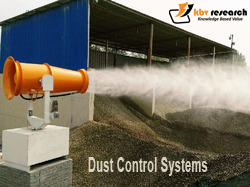The Innovations in Dust Control Systems and Industry-Wide Applications
Clean air is of the utmost
importance when it comes to avoiding various health conditions like asthma and
other respiratory diseases. Nevertheless, rapid industrialization combined with
growing construction and mining activities in emerging economies contributes
significantly to air pollution. This is where dust control systems have gained
widespread acceptance.
What are dust control systems and why have they become so crucial?
Dust control systems are widely
used in various industries to enhance air quality by eliminating particulate
matter from the air. Manufacturers also focus on developing advanced technology
dust control systems. In addition, the governments of different countries are
also adopting environmental and worker safety standards and regulations. This
leads to a higher demand for dust control systems. Manufacturers design
cost-effective and higher-performance dust control systems to improve the clean
production process.
Dust control systems are requisite in these industries:
· Construction
Dust control measures are
applicable across any and every construction site where the potential for air
and water pollution from dust traveling through the countryside or the air is
visible. Dust control includes practices that are used during construction to
reduce or prohibit the surface and air transport of dust. The guidelines of the
EPA are for cleaning and affecting the least possible areas unless they are to
be worked on. Sometimes the clearing and grubbing of the entire site are
performed all at once because of planned operations, although this could be
different on large-scale projects.
No matter how much you monitor
airflow levels through a building site, dust will still be snagged and swirled
around. The dust has to be prevented from escaping the site wherever possible.
This is where cannons that create a fine mist can help to control dust. These
kinds of systems are mobile, and thus can be run exactly where they are
required the most on-site. Some are best suited for outdoor use and will
prevent dust from spreading towards a neighboring building. Others can be
deployed indoors where there may be stone or concrete grinding, thus helping to
trap dust at its source.
· Food and beverages
Dust produced when the food
products are produced and processed cause significant challenges. Particles of
the dust often become airborne, which can endanger the health of workers and
cause outbreaks of combustible dust. Particles from the food dust vary in size,
and some are so fine that they are not visible to the naked eye. Common food
hazards include cereal ingredients, spices, agricultural products for feed and
raw grain, eggshell dust, flour, maize starch, sugar, and flavoring additives.
Traveling dust in a food
processing plant may lead to exposure to allergens or a pathogen outbreak from
microorganisms spreads. Cross-contamination prevention includes a thorough
cleaning of equipment and processing suites— collecting and extracting all
pollutants before they become widespread. Pathogens and allergens collecting,
controlling, and filtering limit the spread of harmful pollutants and prevent
them from returning to the processing area.
· Pharmaceuticals
As per the World Health
Organization, constant exposure to bags of dust triggers diseases, temporary or
permanent disabilities, and deaths in various developed and developing
countries. The production and distribution of pharmaceutical products, such as
medications, supplements, minerals or spices, require a wide variety of
processes that can create harmful dust. The pharmaceutical dust will harm the
workers, pose chemical hazards and contaminate the product. This is a growing
industry with continued demand for adequate tools for dust control and
effective personal protective equipment (PPE).
How can different industries benefit from microscopic ‘smart dust’ sensors?
Smart dust is the next logical
progression for today's Internet of Things (IoT). The IoT market has developed
itself rapidly as an essential element of the contemporary world. Devices vary
wildly, from consumer devices like smart thermostats to big business-made
products like small sensors that track oil wells to ensure efficient
performance.
Several users have already been
considered: tiny smart dust motes could be installed across farm crops to
monitor plant needs, from determining watering times to controlling pests.
Smart dust elsewhere may track bees to find out where they encounter different
chemicals that harm their populations.
Small sensor networks have
already been developed by a variety of industrial sectors to track machinery
across a plant or factory. Apart from oil refineries, chemical plants and mines
are locations where the already developed sensor networks could be upgraded to
smart dust as soon as the technology becomes usable. In addition to tracking
their equipment, large-scale consumer goods companies (such as packaged food
producers or breweries) can use smart dust to improve inventory control and
improve safety by monitoring their products wirelessly.
To sum up
The need for clean air is rising
with increasing levels of pollution, combined with growing respiratory problems
in urban areas, which are expected to contribute significantly to the growth of
the industry. The increasing need for product adoption, particularly in
developing regions around the globe, is expected to drive demand over the
forecast period.
Dust storms can create impacts on
the environment, like reduced solar radiation, geochemical and biogeochemical
effects, damaging primary marine producers or autotrophs. One explanation of
why dust has these global effects is its transferability of up to 20,000 km.
Dust may also adversely affect the cardiovascular, respiratory, cerebral and
vascular systems. It may cause or increase meningitis, fever, pain, allergies,
and viral infections; it could also damage the DNA of the skin and lung cells.



Comments
Post a Comment